MOTOROLA
POLICE MOTORCYCLE RADIO INDEX
1947-1992
PART TWO, 1958-1992
TRANSISTORIZED DISPATCHER ("A" Series, 1957-1961)
In June, 1957, the first partially transistorized motorcycle radio was offered, and it was revolutionary in design. It was initially called "The Research Line Transistorized Motorcycle Dispatcher." Even though the "5V" radio of 1947 was referred to as "Dispatcher," in the industry, this new radio has always been referred to as the "Motorcycle Dispatcher." Because of the considerably lighter weight, less than 20 pounds, the mounting was moved to a housing on top of the rear fender, as this radio was a one-piece unit (mounting kits were available for placing the radio inside one of the rear side factory made saddlebag housings if desired.) Initially, these radios were supplied with a claw-style bracket for microphone mounting on the handlebars as in the previous Twin-V vacuum tube radios, however, by about 1961 the microphone mounting was changed so that it was hung on the left side of the control head, in a clip riveted to the cable exit cover. The first generation microphones for these radios were the same as used on the Twin-V and Research sets, and the transition to the microphone hang-up on the control head came with the redesign of the microphone to the familiar style shown below. Also for the first time, the Solocycle and Servicar radios were the same. The radio was available in two mounting configurations, a totally one piece radio with the controls on top, for mounting between the handlebars and windshield on a Hydra-Glide fork type Harley Davidson motorcycle (see photo below,) and a "remote" mount design where only the traditional control head was mounted on the handlebars and the rest was in a weather housing over the rear fender or in a saddlebag mount (see photos below.)
Note that the original heads as supplied were two-tone gray and cream-beige (called "driftwood" by Motorola) while quite soon after introduction the heads were also being supplied as an all black item.
CLICK HERE FOR A PDF COPY OF THE ANNOUNCEMENT OF THIS RADIO ( 424 kb download)
These radios made use of the "PLA-cir"® printed circuit boards as employed in the hand-carried partially transistorized pack set portable radios which were introduced approximately a year earlier, in early 1956. The circuit boards and chassis were arranged to fold out like the pages of book for "easy service," although there was no centralized metering jack and alignment or service meant seemingly endless changes of the location of an "Ez-Hook"® multimeter probe. These radios all used Germanium transistors; the circuitry was completely powered from the secondary side of the power transformer in the power supply, such that the positive ground of the receiver chassis was unrelated to the ground polarity of the vehicle battery and chassis.
The initial model numbers were T33-1 and T31-1 for the low band remote mount versions, and D31-1 and D33-1 for the high band models, however these numbers were rather quickly superseded by the "Twin-V era" numbering scheme of T or D 31AAT and T or D 33AAT, followed by a 4-digit suffix indicating the number of channels, carrier or Private Line® tone squelch, and so forth.
It should be noted that Motorola did not consider these as solely a motorcycle radio, and later referred to them as "industrial" radios. Many were found on forklifts and similar industrial vehicles, and a locomotive version (Z33AAT) was produced sometime in 1961 which apparently ran off 72V DC or 117V AC.
These radios had receivers which were almost fully transistorized, used a transistorized power supply and had a hybrid (partially tube and partially solid state) transmitter. The power drain on receive was so low that the cycle could be stopped for fairly long periods with the engine off and not have the receiver drain the battery. In order to reduce battery drain and heat, the transmitter tubes were "instant heating" types which did not have their filaments powered until the microphone button was depressed. This meant that there was a slight delay necessary before the user could begin to talk, in the neighborhood of one second. The receiver audio power was increased to 5 Watts, compared to the old 1 watt tube type receivers. The same equipment was also made for industrial use on forklifts and the like, and also in a "front mount" configuration with the radio and control head all mounted in a single housing. To achieve the small size, subminiature wire lead tubes were used wherever a tube was still employed, other than the transmitter driver and final amplifier, where round glass subminiature 6397 tubes were used as drivers, feeding a glass octal 2E24 tube (an instant-heating version of the 2E26.)
The Transistorized Dispatcher usually was found in a stamped metal weather housing as shown below. There was also a far less popular vinyl housing with snap buttons, which stretched over a steel frame, almost like a car's convertible top. It is not know why they offered this alternative housing, which never made another appearance. The Transistorized Dispatchers locked into their trays using a small steamer-trunk-looking lock, although it was not necessary to lock the rack. An optional mounting tray was also available to allow mounting of the radio package inside the hard-shell saddlebag boxes of 1960's vintage Harley Davidson cycles, rather than above the rear fender., as mentioned above
These radios came in three sections. The bottom, detachable section, is the power supply. It was available in many voltages, usually coming in either 6 or 12 Volt versions, although 24, 32, 72 and 120 Volt (AC) versions were made. Motorcycle versions were sold with the 6 Volt power supply, although conversion kits were made available by 1964 to convert the radios to 12 Volt operation.
This radio was one of Motorola's most successful and possibly the longest lived product in their history, stretching over the ten year period from 1957 to 1967 and the radios often still being in use 20 years after purchase.
The control heads for these went through a number of changes in the pre-1962 years, apparently as Motorola used up excess parts from the production of the Twin-V series of the mid 1950's, which was rather rapidly discontinued when the Transistorized Dispatcher production was able to supply demand. All of these early heads have two tone paint schemes with the outer bezel having more of a yellowish beige tint than the Twin-V, which was a light gray. Motorola called this color "Driftwood." These initial heads did not have the microphone hang-up assembly on the left side (see later head below) and had the cables exiting from two holes and clamps in the rear, similar to the Research and Twin-V heads of the earlier years. The example below is an NU-181 control head for a first generation T31-1 or T33-1 radio. Note that someone has added the side housing from a later head to get the microphone hang-up feature. Normally that side housing protected the cable exit on later heads, while on this example the cable exits from the rear. It appears that the date on this one is in 1960.
Note that heads were also available initially with a red pilot lamp. The photo below shows the NCN 6035 AE head, a new old stock example from approximately 1959 seen on eBay in February, 2019. Most heads were later manufactured in a smooth black without the pilot lamp.
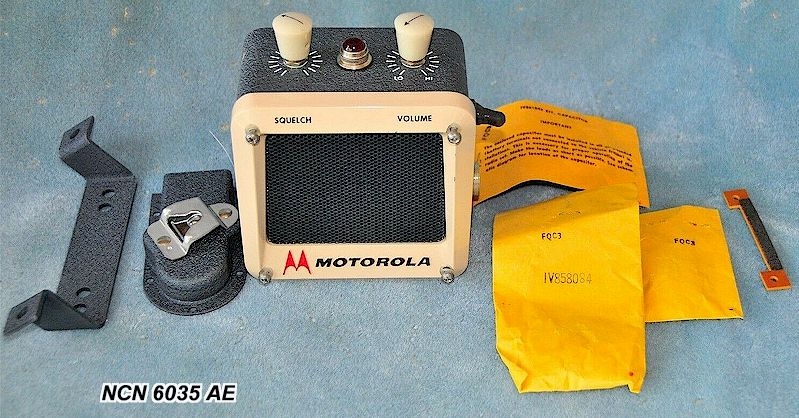
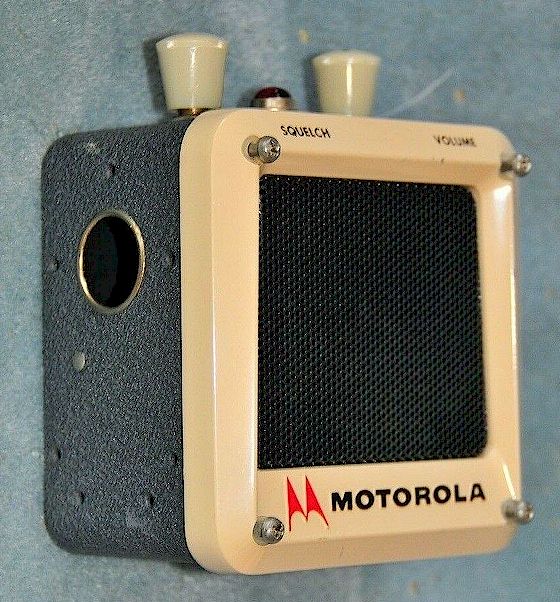
Control heads for the T33BAT and T31BAT series with the solid solid state receiver (later model) after 1962 were usually gloss black with the microphone hanger integrated into the head on the left side as shown above. The earliest heads were a two-tone cream-gray, as shown above and shipped with the T33-1 and T31-1 sets, and initially did not have the microphone hanger on the head and had the cables exiting on the rear.
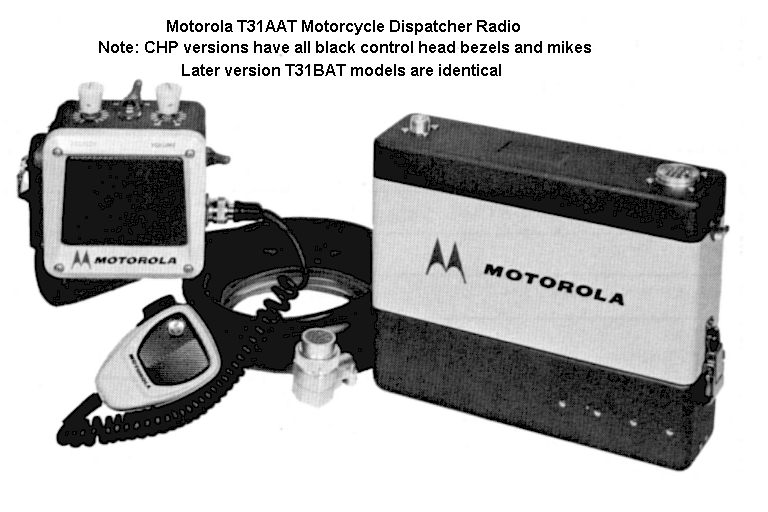
Below, an example of a T31AAT with a black control head, used by CHP in approximately late 1962. Note the lack of a microphone hanger on the left side of the head.
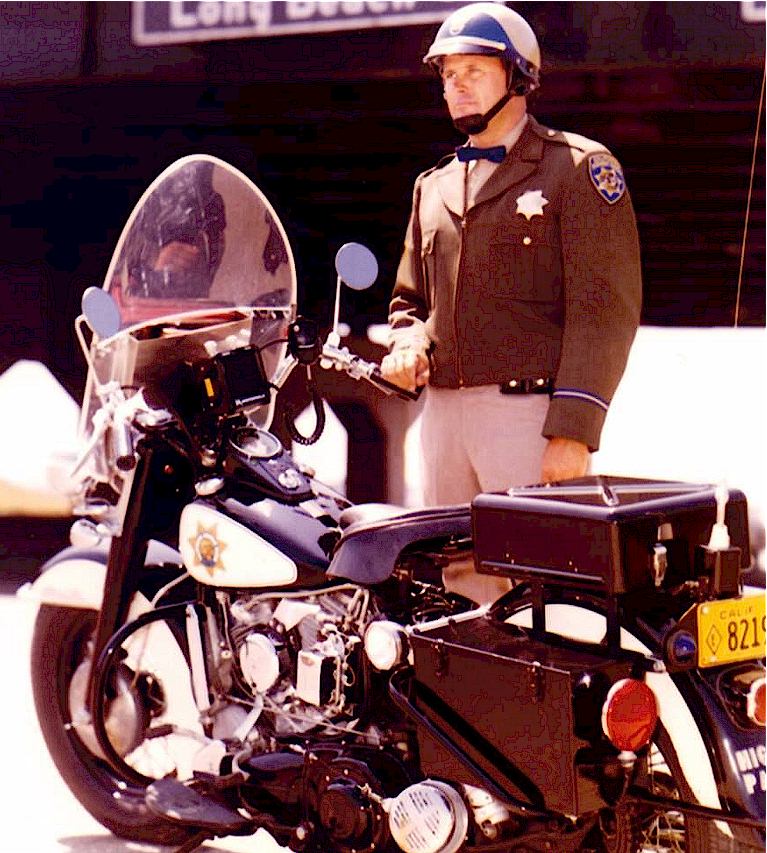
Below is an example of the one-piece front mounting equipment, D33BAT. First generation versions had slightly larger diameter knobs. These were not widely used this way and saw more service in Jeeps and forklifts.
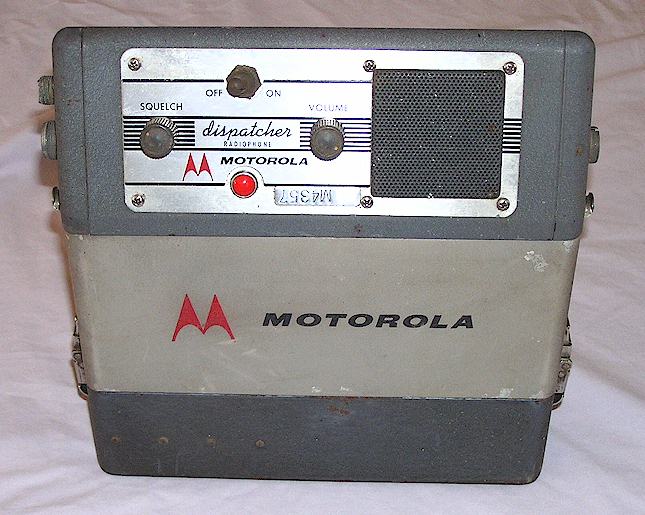
Below is an example of the saddlebag style of mounting. Prototype photo from Motorola-Harley Davidson, used in installation manuals for T33-1 and T33AAT Series.
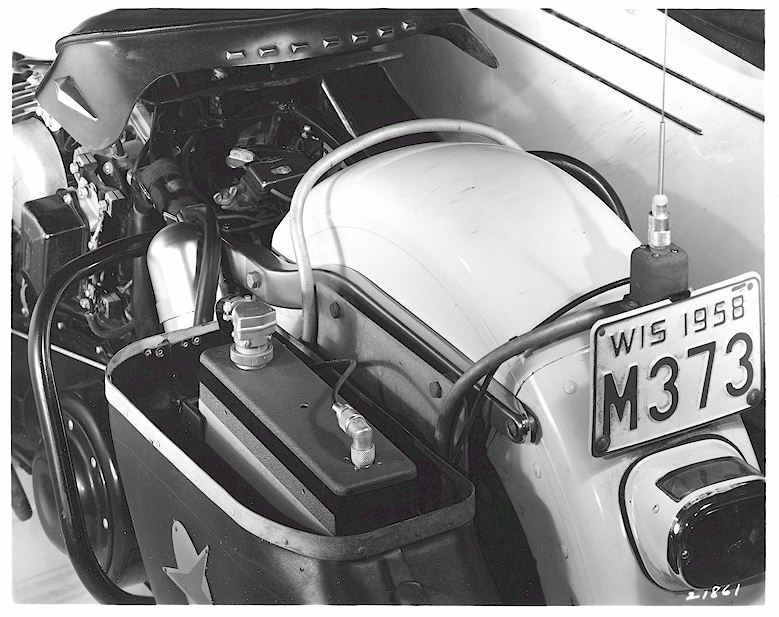
TRANSISTORIZED DISPATCHER ("B" Series, 1961-68)
The "B" version of the Transistorized Dispatcher is practically the same as the "A" version, and was introduced about 1961. The "B" sets have a fully transistorized receiver, and the power supply is different and uses somewhat more modern components. Physically, the paint shade on the "B" version of the radio has a light beige center housing while that of the "A" version was light gray. The model series of the "B" sets was typically T31BAT-1100 while that of the "A" was T31AAT-1100, by way of example. The Transistorized Dispatcher was only made in VHF low and high bands; there was no UHF model.
SOLID STATE DISPATCHER (1966-1974)
The solid state Dispatcher was introduced in approximately 1966 and was produced through about 1974 before being replaced by the MCR-100 series. They were not too common. A typical model number would be T43DDN-1100A or T43DEN-1100A. These radios were fully transistorized and used the circuit boards from HT-200 hand-held portable sets along with additional amplifiers for transmitter power and receiver audio output. Because the HT200 circuit boards are natively positive ground, they are isolated from the chassis in this model with rather a great deal of assorted capacitive coupling in and out of them. Damaging these circuits was relatively easy and these radios did not have a very favorable reputation. The housing of the Solid State Dispatcher is a thick high-impact molded gray plastic. The control head is almost the same as the Transistorized Dispatcher, but with different knobs, and the grille was generally chrome plated. The Solid State Dispatcher mounted over the rear wheel, although a tray was offered to allow mounting inside one of the Harley Davidson hard-sided saddlebag boxes if desired. The standard outer weather housing was now rectangular molded ABS plastic, with square corners, and with a "M" Motorola logo molded into the top. The antenna was usually mounted through a provided hole in the housing cover, although installations could also mount the antenna separately on a metal tab extending rearward as in the photo below. This radio was a 12 Volt only unit and had a 10 watt power rating on VHF and about 8 Watts on UHF. The Solid State Dispatcher was made in all three bands. The same chassis was used in an unrelated UHF radio called the "Airport Dispatcher," a dash mount industrial radio intended for flight service trucks.
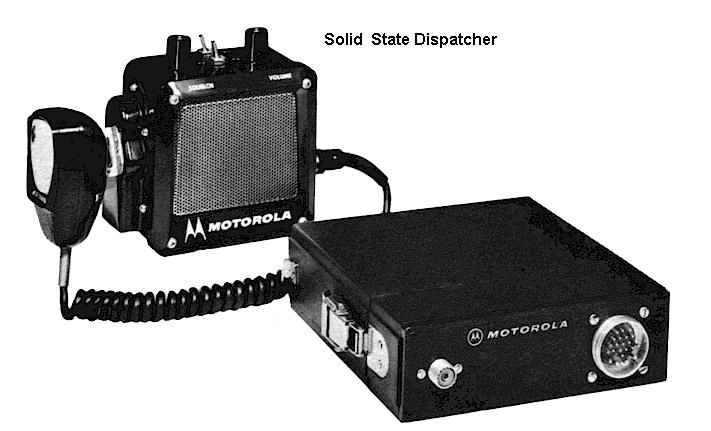
Shown below is a typical antenna installation, UHF, on a bracket separate from the box lid. It was also possible on production models to place the antenna on the lid center, where a hole was provided and capped with a plastic button at the factory. The low band models would have used this antenna mount as well.
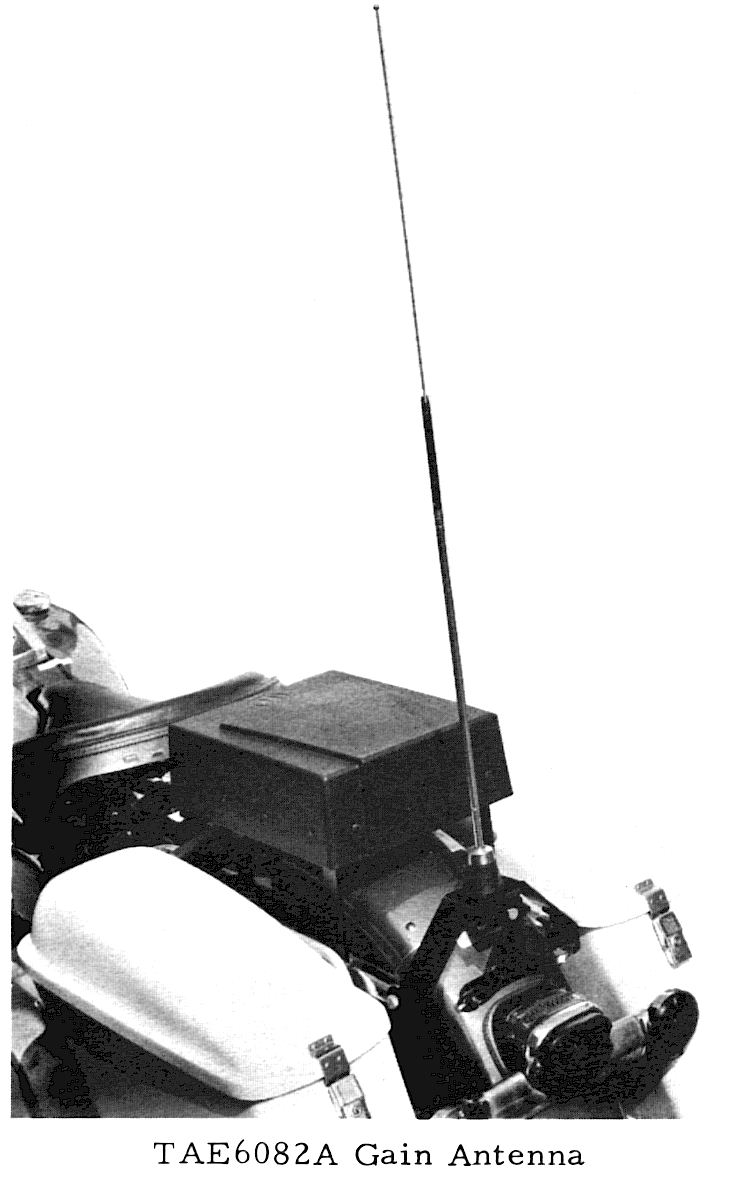
Shown below is a somewhat shabby special 4-frequency Solid State Dispatcher control head made for a California police agency, possibly Los Angeles Police. The normal control head would have had two channels maximum, selected by a toggle switch. This head saw a lot of use, so much that the plating has worn off the "PL" switch (Why? You normally leave it "ON" and forget about it.)
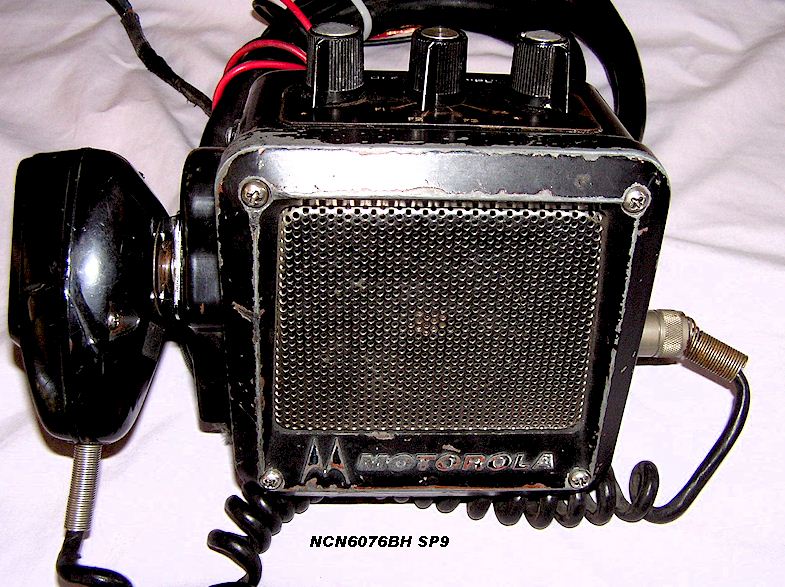
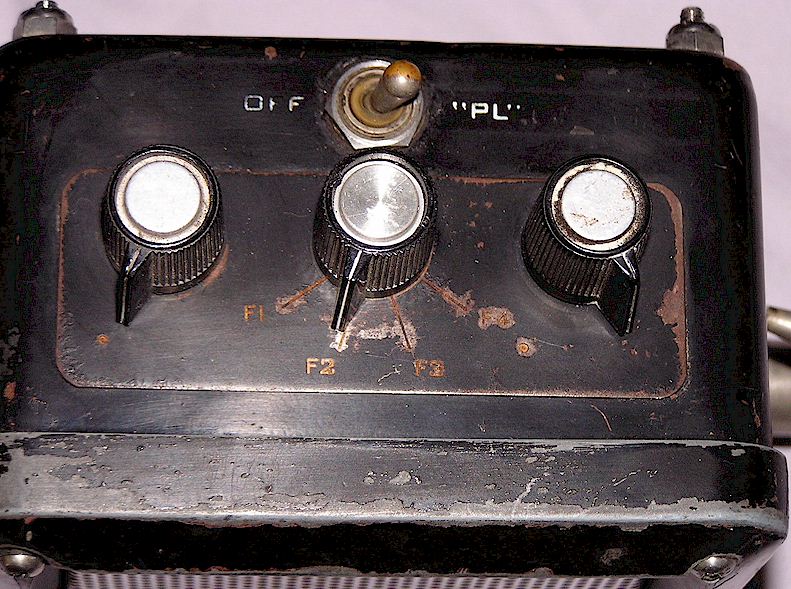
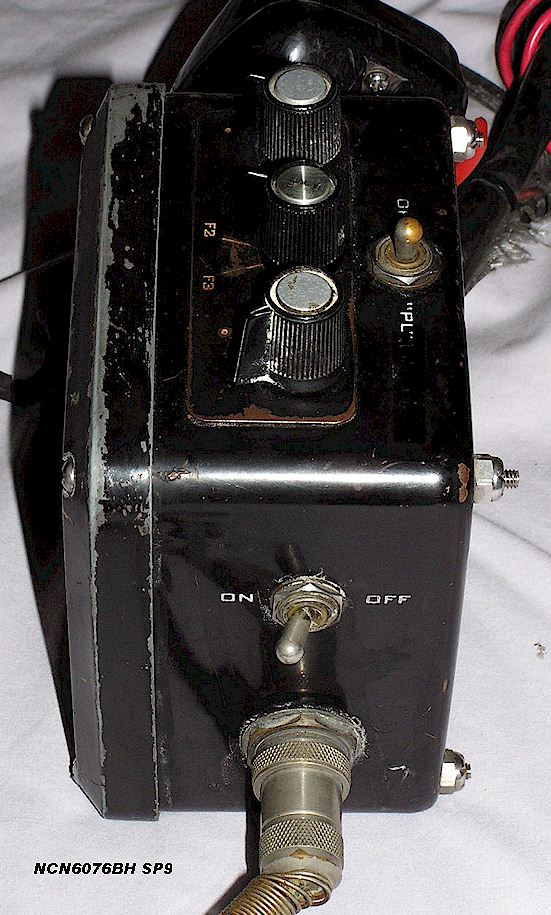
MCR-100 (1974-1980)
The MCR-100 was an early 1970's replacement for the Solid State Dispatcher and was similar to a Mocom 35 dash mount car radio. It was introduced in approximately 1974 and stayed in production through about 1980. It was the first radio to use channel elements, a self contained temperature compensated oscillator module, as opposed to just crystals. The MCR-100 was the first off-the-shelf radio to be available with up to 12 channels, and was about the same size as the Solid State Dispatcher radio except in a stamped steel housing rather than molded plastic. They were used in large quantities in the USA as well as foreign countries, and are probably the most common radio found today.
The MCR-100 weather housing was a large fiberglass dome shaped assembly with an aluminum plate insert to act as a ground plane for the antenna. The head continued to use the basic stampings of the previous models except that the large round channel selector knob is a feature found only on the MCR-100 vintage radios, as is the red pilot light. The weather housing was usually black, although it could be ordered in white. There was a key lock on the housing which used the standard Motorola 2135 mobile key.
The MCR-100 was made in high and UHF bands only, and is similar to a trunk-mounted version of the Mocom-35 dash mount mobile radio. The MCR-100 represents Motorola's exit from "off the shelf" low band motorcycle radio production.
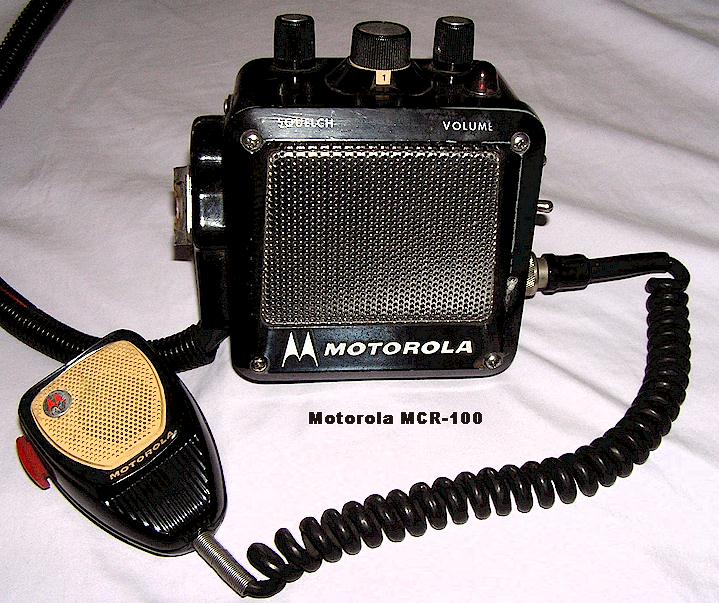
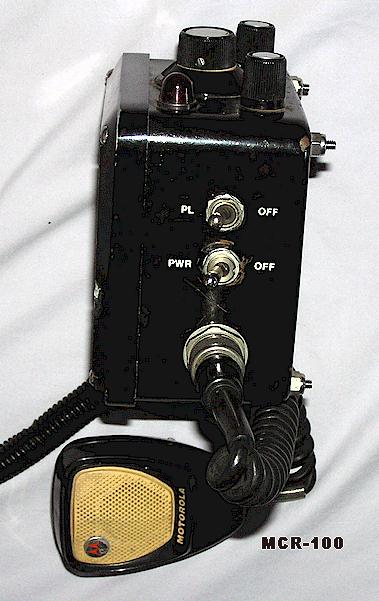
Photos above of Salinas, California Police UHF MCR-100 (1980's)
MCX-100 (1980-1986)
The MCX-100 was a Canadian Motorola product which was essentially a compact version of the circuitry used in the much larger Syntor mobile radio, and was introduced about 1980. The MCX-100 was available in either a dash mount or a trunk mount car version, as well as a motorcycle set. The trunk mount version carried a different model number than the motorcycle version, but appears identical as far as the radio package, the only difference being that the motorcycle head has weatherproof rubber booted switches and sealed controls, a weatherproof speaker and a separate high power external audio amplifier is added. The MCX-100 represented the first time Motorola departed from the "all-in-one" control head, using instead a separate control head and speaker, as well as a separate microphone hanger once again. The MCX-100 control head contains a two digit LED channel indicator in the display and is capable of 8, 16 or 32 channels, although 8 was most common. There was also a less-featured MCX-90 version, with fewer channels and options, although it is not known whether that series was ever sold as a motorcycle radio.
The fiberglass weather housings for the MCX-100 were usually supplied in black, with the antenna mounted on top. The housings are basically the same as the MCR-100 housings.
The MCX-100 is a synthesized radio, which uses a rather obscure one-time PROM chip to determine frequency. That being said, the MCX-100 is not a broadband radio; it is necessary to align it to a given slice of the spectrum, about 4 MHz wide. Nonetheless, the MCX-100 is a very good radio with high reliability and performance. The MCX-100 was available in several power levels, the highest being 25 Watts. This radio was only available in VHF high band and UHF. There were no low band models.
Note-The weather box shown below may actually have a tray in it for the MCX1000 or the Spectra. That is what happens when you have too many radios and fail to organize them well! In any case, the box itself is the same one used for the MCX100 and MCX1000.
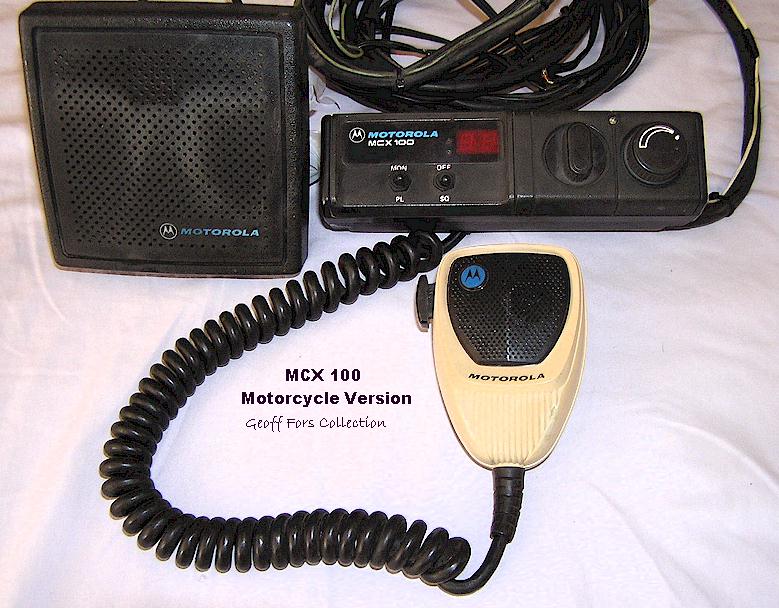
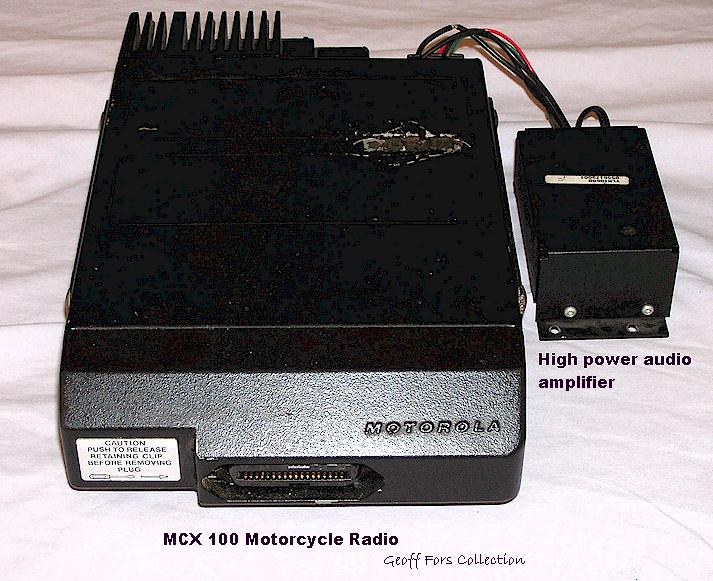
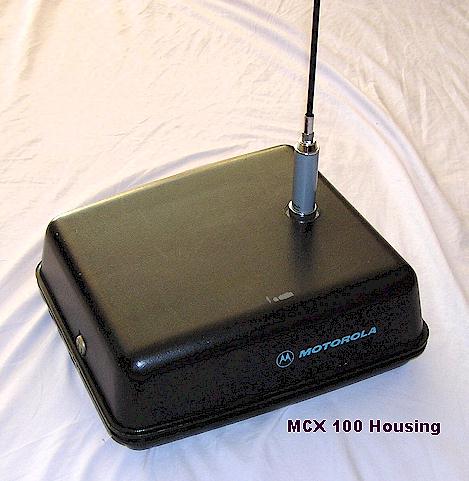
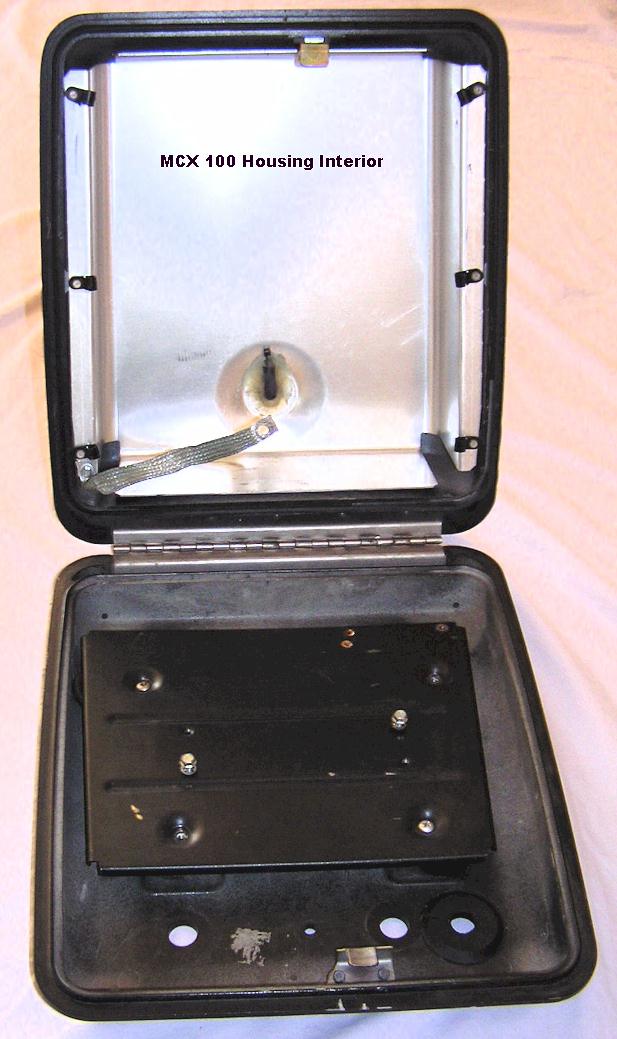
MCX-1000 (1986-1994)
The MCX-1000, also made in Canada, is very similar in appearance to the MCX-100, but some of the differences are that the MCX-1000 has a blue vacuum fluorescent display and is computer programmable through a "RIB" (radio interface box) unit and an IBM DOS computer. Like the MCX-100, the head and speaker are separate units. Apparently the MCX-1000 was only manufactured in a VHF motorcycle version, according to Motorola's master manual index, which seems odd, since a regular UHF version was manufactured for cars and as a tabletop base station.
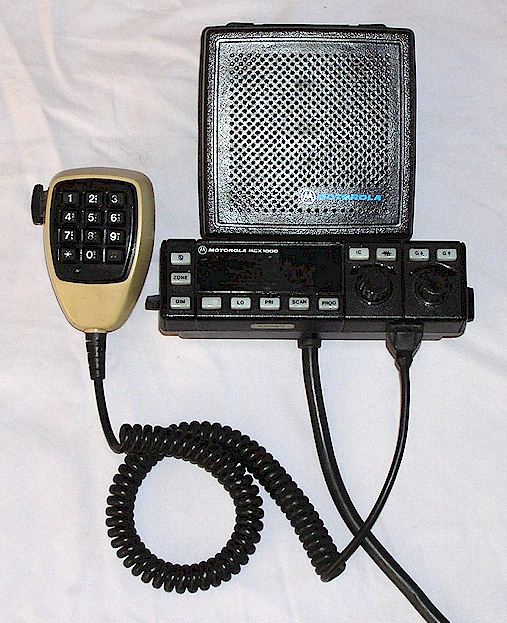
SPECTRA / ASTRO SPECTRA (1989-2004)
The Spectra was introduced in the late 1980's and is Motorola's dash mount synthesized software programmable radio which uses a blue vacuum fluorescent alpha-numeric display. It was produced through about 1999 when it was replaced by the Astro Spectra, a digital-capable radio, which was produced through about 2004. The Spectra was also made in a trunk-mount version, and as with the MCX-100, that version became a motorcycle radio. Like the MCX-100 and 1000, the Spectra motorcycle head is essentially the same as the car radio version. The A5 motorcycle head is shown below. In the early 1990's the Astro Spectra (digital version) was introduced.
Photo below courtesy Scott Cacciamani, Staten
Island NY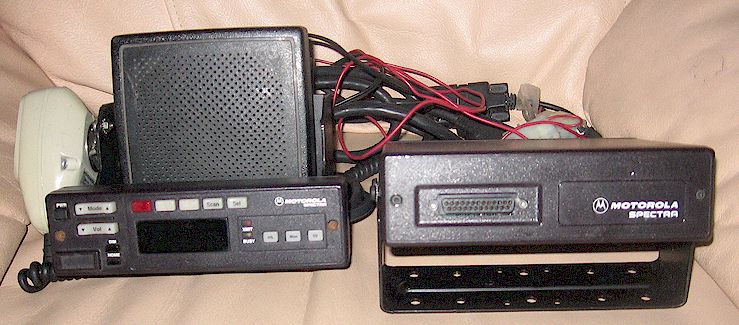
Shown below is an Astro Spectra motorcycle radio with the W4 Series control head.
Photos below courtesy Jason Rasmussen, KB9KST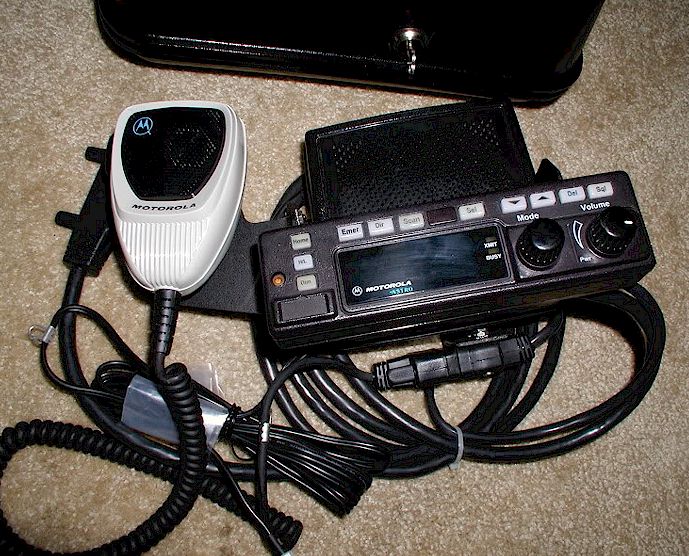
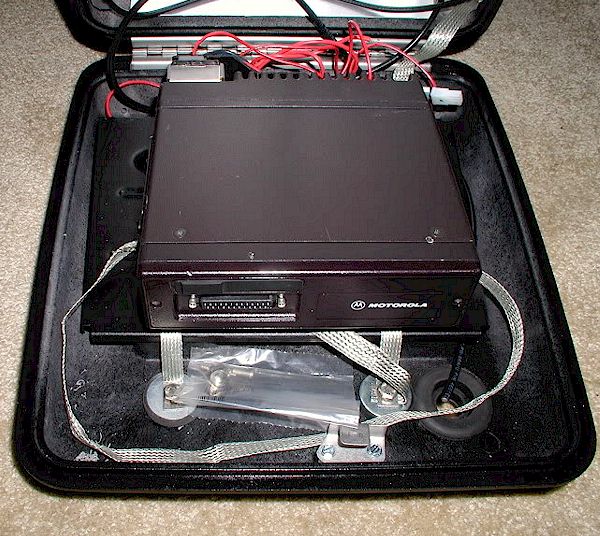
Note: One of the reasons I created this page is that I have noticed that there are a number of unscrupulous people attempting to put together "fake" Motorola police motorcycle radios out of automobile style mobile radio parts, usually by creating Photoshopped so-called "original" pictures or prop examples, to try to prove that the radios were actually used on motorcycles as part of their eBay ad. Until the MCX-100 series, Motorola never offered a car style radio for use on motorcycles, nor did any agency I am aware of, try to use them that way. The car radios are not weather or vibration proof at all, and were generally too heavy to have been capable of motorcycle mounting in any case. Specifically, neither the Motrac or Mocom 70 radios were ever sold as motorcycle radios, including Servicar applications. Please do your homework before you wind up parting with money for a "pig in a poke!"
Ver. 02/13/2023 © Geoffrey C. Fors, 2007, all rights reserved